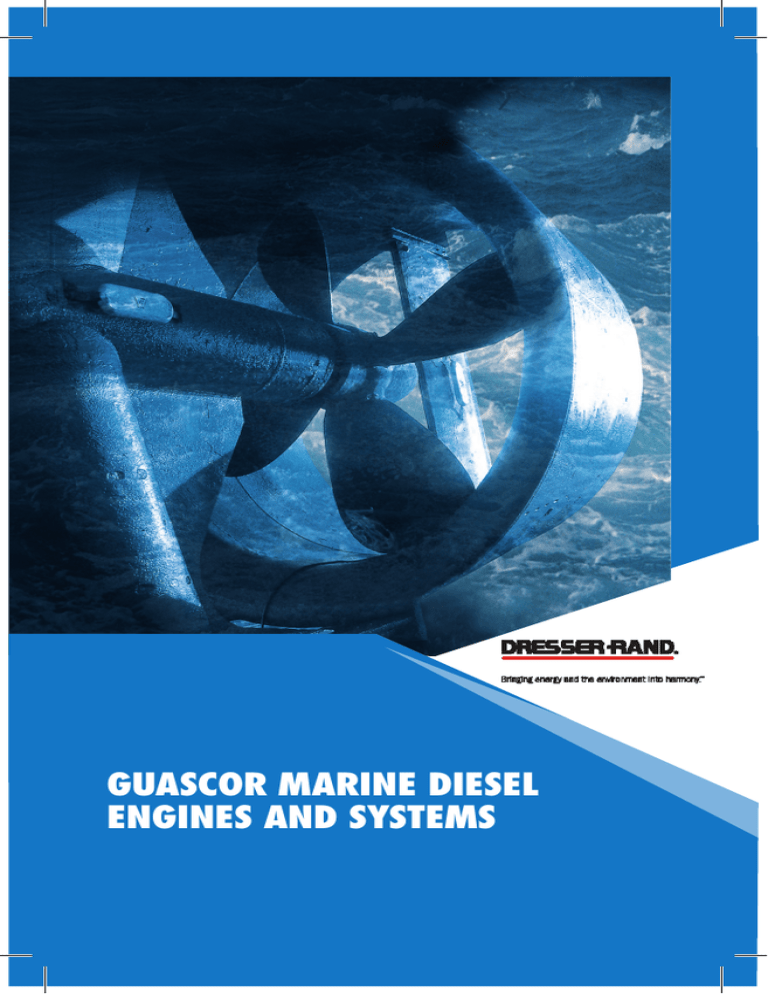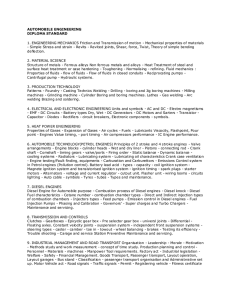tech sheet-Eng
advertisement

Guascor MARINE DIESEL ENGINES AND SYSTEMS 1. POWER DEFINITION Dresser-Rand’s Guascor diesel engines ratings stated in this document are based in ISO3046-1:2002(E), ISO3046-3:2006(E), ISO15550:2002(E). These ratings have been measured including all engine driven mechanical pumps. Abbreviations ICFN / IFN I = ISO Standard (3046) C = Continuous F = Fuel stop power N = Net power Our Guascor diesel engines are designed following the reference conditions. On vessels approved and/or surveyed by IACS members, “standard design conditions” are to be observed. Standard reference conditions ISO 15550:2002 • Total barometric pressure: 100 kPa / 1000 mbar • Air temperature: 25ºC (77ºF) / 298 K • Relative humidity: 30% • Charge air coolant (raw): 25ºC (77ºF) / 298 K • Charge air coolant (treated): 29ºC (84ºF) / 302 K Standard design conditions ISO 3046-1:2002 & 3046-3:2006. • Total barometric pressure: 100 kPa / 1000 mbar • Air temperature: 45ºC (113ºF) / 318 K • Relative humidity: 60% • Charge air coolant (raw): 32ºC (89ºF) / 305 K • Charge air coolant (treated): 36ºC (96ºF) / 309 K 6 s. 2. RATING DEFINITIONS PROPULSION A - Rating (unrestricted continuous duty) Rated power intended for continuous use in applications requiring uninterrupted service with high load factors; this is an ISO standard (continuous) fuel stop power (ICFN) Typical load factors: Full load operation time: Operation time: Operation type: Typical applications: 80-100% of rated power 100% of time or 24/24h 5,000 - 8,000 h/year Displacement hull vessels for unrestricted use at full speed and load Fishing trawlers, bottom trawlers, freighters, tankers, tow & push boats, long distance ferries, dredgers, cabin cruiser, research vessels B - Rating (variable continuous duty) Rated power intended for use in variable load applications, medium-high load factors; this is an ISO 3046 fuel stop power (IFN). Typical load factors: Full load operation time: Operation time: Hull type: Typical applications: 40-80% of rated power 80% of time or 10/12h 3,000 - 5,000 h/year Semi-planning or semi-displacement hulls for restricted use at full load Mid-water trawlers, fishing long liners, purse seiners, harbour tow & push boats, passenger cruiser, tugboats, short distance ferries C - Rating (intermittent duty) Power intended for use in variable load applications with moderate load factors. This is an ISO 3046 fuel stop power (IFN) Typical load factors: Full load operation time: Operation time: Hull type: Typical applications: 20-80% of rated power 50% of time or 6/12h 1,500-3,000 h/year Semi-planning or planning hulls, fast commercial and passenger vessels for restricted use with moderate load factors and high demands on vessel’s speed Passenger boats, high-speed fishing boats, crew and service boats, moto-pumps, pilot boats 7 DIESEL ELECTRIC PROPULSION COP (continuous power) Rated power (ISO8528) intended for continuous use in applications requiring uninterrupted service with high load factors for an unlimited number of hours per year; 10% overload available in a period of time of 1/12 operation hours and maximum 25 h/year. Typical load factors: <80% of rated power Full load operation time: 100% of time or 24/24h Overload: 110% overload available 1/12h and max. 25 h/year Operation time: 5,000 - 8,000 h/year Typical applications: Ferries, research vessels, passenger cruiser, tugboats, offshore vessels, freighters and tankers AUXILIARY AND GENERATOR SET COP (continuous power) Engines with this rating (ISO 8528) are available for supplying utility power at a constant 100% load for an unlimited number of hours per year. A 10% overload capability for a period of time of 1/12 operation hours and maximum 25 h/year is additionally allowed to that specified on ISO 8528. Typical load factors: 80-100% of rated power Full load operation time: 100% of time or 24/24h Overload: 110% overload available 1/12h and max. 25 h/year Operation time: 5,000 - 8,000 h/year 8 g s m 3. FUEL CONSUMPTION The fuel consumption values published in this document have been calculated according to ISO8178 standard test cycles (ISO8178 E3 Propulsion, E2 Electric propulsion and D2 auxiliary applications). These values must be considered as indicative guidance but not considered absolute values. Fuel consumption may vary as it can be influenced by external factors such as ship application, different environmental conditions, particular propeller design, hull form, etc. ISO 8178 test cycles and weighting factors E3 Test Cycle: Main propulsion and auxiliary engines adapted to propeller demand Mode Number 1 2 3 4 5 % Speed 100 91 80 63 - % Power 100 75 50 25 - Weight Factor 0.2 0.5 0.15 0.15 - E2 Test Cycle: Main propulsion engines at a constant speed Mode Number 1 2 3 4 5 % Speed 100 100 100 100 - % Power 100 75 50 25 - Weight Factor 0.20 0.50 0.15 0.15 - r D2 Test Cycle: Auxiliary engines at a constant speed Mode Number 1 2 3 4 5 % Speed 100 100 100 100 100 % Power 100 75 50 25 10 Weight Factor 0.05 0.25 0.30 0.30 0.10 Fuel consumption rates are based on ISO3046-1 with a tolerance of +5% and is based on diesel gasoil B with LHV 42700 kj/kg (18358 Btu/lb)when used at 29ºC (85ºF) and weighing 836 g/liter (6977 lb/US gal) Extensions of this information should be compared with the specifications indicated in the mentioned standards. All technical information and data within this document is subject to modification without prior notice. 9 4. EMISSION CERTIFICATIONS IMO (International Maritime Organization) On January 1, 2000, annex VI of MARPOL 73/78 went into effect for all marine diesel engines above 130kW/177HP installed on vessels whose keel is laid after January 1st and which do not operate exclusively in national waters. Current revision (Tier II) entered into force from January 1, 2011. • IMO apply to sea going vessels • IMO apply on engines rated above 130 kW / 177 mHP • Emergency on-board engines are exempt to accomplish IMO regulations CCNR (Central Commission for the Navigation on the Rhine) Effective January 1, 2003, the CCNR regulates exhaust emissions limits for all marine diesel engines above 37kW/50HP installed on inland waterwaygoing vessels running through the Rhine or its tributary rivers. Members of the CCNR include: Belgium, Netherlands, Germany, France, Luxembourg, and Switzerland. Current revision (CCNR II) entered into force effective January 1, 2007. • CCNR rules apply to inland waterway-going vessels • Applies on engines rated above 37 kW / 50 mHP • Equivalent to EU directive for non-road mobile machinery 97/68/EC, as amended by directive 2004/26/EC, mutual recognition agreement effective July 1, 2007 Abbreviations This document contents the following abbreviations which will appear on subsequent pages to identify the emission regulation compliance of each engine type and/or rating. • N.C. • N.A. • IMO1 • IMO2 • CCNR2 • DEP • COP • mHP • kW • KVA 10 Not compliant or not applicable Not applicable IMO Tier I compliant (see IMO2) EIAPP certificates available for engine replacement only for all diesel engines placed on a vessel before December 31, 2010 IMO Tier II compliant; EIAPP certificates available since January 1, 2011 CCNR Stage II compliant Diesel electric propulsion Continuous power Metric horsepower (DIN) Kilowatt Kilovolt amper l 5. MARINE CLASSIFICATION SOCIETIES Dresser-Rand’s Guascor marine engines, gen-sets and gear boxes are designed and built according to the rules of major marine classification societies worldwide. Approvals from major marine classification societies worldwide include: • ABS • BV • GL • LR • RINA American Bureau of Shipping Bureau Veritas Germanischer Lloyd Lloyds Register Registro Italiano Navale Some marine products or ratings may differ depending upon class society. For more information on emission or marine classification society certifictions, please contact your local Dresser-Rand office for Guascor marine engines, gen-sets and gear boxes. All information published in this booklet may be modified without prior notice. 1 11 F/SF240 SERIES PROPULSION MAIN DATA Cycle (ISO 8178) Disposition Displacement Cycle Combustion system Aspiration Bore and stroke Rotation (from flywheel) E3 (propulsion) 8 L 23.96 liter 4-stroke diesel Direct injection Turbocharged and aftercooled 152 x 165 mm (5.9 x 6.5 in) Counterclockwise Propulsion ratings Rating kW mHP RPM Series Fuel consumption (ISO 8178) L/h Gal/h A 478 650 1,800 F 80.7 21.3 A 552 750 1,600 SF 92.8 24.6 IMO2 A 577 785 1,800 SF 97.0 25.6 IMO2/CCNR2 A 588 800 1,800 SF 99.1 26.2 IMO2 A 610 830 1,800 SF 102.7 27.2 IMO2 IMO2 B 493 670 1,800 F 83.1 22.0 IMO2 B 635 864 1,800 SF 107.2 28.4 IMO2 C 662 900 1,800 SF 112.1 29.6 IMO2 D DIMENSIONS & WEIGHT Length (mm / in) 2,600 102 L Width (mm / in) 1,200 47 W Height (mm / in) 1,600 63 H Dry weight (kg / lb) 3,500 7,716 Dimensions and weight may vary depending upon engine configuration. Data subject to further modifications without prior notice. 22 Emissions D D D F/SF 240 AUXILIARY MAIN DATA Cycle (ISO 8178) Disposition Displacement Cycle Combustion system Aspiration Bore and stroke Rotation (from flywheel) D2 (auxiliary ) 8 L 23.96 liter 4-stroke diesel Direct injection Turbocharged and aftercooled 152 x 165 mm (5.9 x 6.5 in) Counterclockwise Auxiliary ratings Rating kW mHP RPM Series Fuel consumption (ISO 8178) L/h Emissions Gal/h A 426 580 1,500 F 51.8 13.7 IMO2 A 510 694 1,500 SF 60.5 16.0 IMO2 A 540 734 1,500 SF 63.6 16.8 IMO2 A 478 650 1,800 F 62.3 16.5 IMO2 A 577 785 1,800 SF 72.6 19.2 IMO2/CCNR2 A 588 800 1,800 SF 73.9 19.6 IMO2 DIMENSIONS & WEIGHT Length (mm / in) 2,600 Width (mm / in) 1,200 47 Height (mm / in) 1,600 63 Dry weight (kg / lb) 3,500 7,716 102 Dimensions and weight may vary depending upon engine configuration. Data subject to further modifications without prior notice. 47



